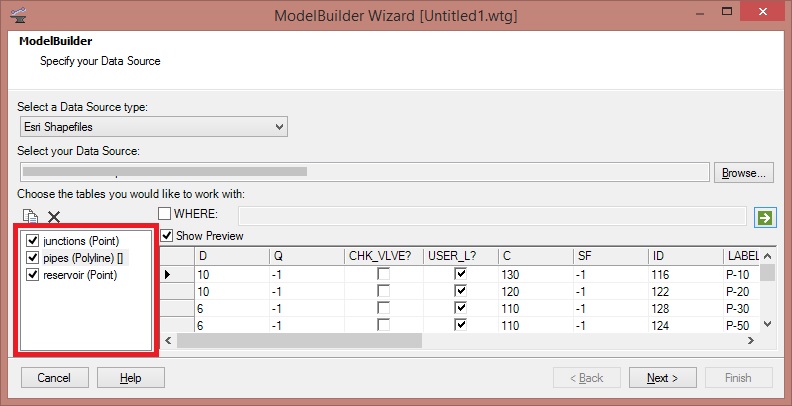



Model Building Tools Demand Allocation using meter dataĮPANET WaterCAD WaterGEMS Demand Allocation using meter data Demand Allocation using population Demand Allocation by land use or area Includes Average Demand Libraries? Includes Material Libraries? Terrain Elevation Extractor SCADA connection * Network Skeletonization User-defined attributes Associate external files (photos, videos, etc) * Available in WaterCAD as an Add-On Once you have laid out the pipes, nodes, etc you will need to assign physical properties, elevations and demands to the model. Demo 3: Convert polyline to pipe, shapefiles, work in the CAD platform, StandAlone, ArcGIS – since these tools are not available in EPANET (show they are not) we will concentrate in a few of these tools found in WaterCAD/GEMS Available Limited Not Availableħ 4. WaterGEMS, on the other hand, allows you not only to convert your data, but also to maintain a constant connection between the source and the model, you can export data back to the source, or if you prefer to work directly in CAD or GIS you can run WaterGEMS inside of MicroStation, AutoCAD or ArcGIS. So the model building process is very precarious because you have to enter the elements and data manually one by one. nor does it allow to bring tabular data such as excel. EPANET does not convert data into pipes, nodes, etc. Usually, the data is either in CAD files, GIS shapefiles, excel or other databases. JPG Excel import/export Oracle, SQL import/export Import/Export EPANET files * Available at an additional cost If you don’t have a hydraulic model yet, or, if you are planning to expand your existing model, you have probably wondered if there is an easy way to re-use data that you may already have. Demo 2: WTRG – hydrant – isolation valve – variable speed pump – hydropneumatic tank Available Limited Not AvailableĮPANET WaterCAD WaterGEMS Database import/export Convert CAD to pipes Shapefile import / export Runs inside of ArcGIS Runs inside of AutoCAD * Runs inside of MicroStation Background CAD, shapefiles. So we’ll take a look at some of those special elements in WaterGEMS. If you have isolation valves, hydrants, variable speed pumps, hydropneumatic tanks, air valves, etc., you don’t want to leave them out of your model because they are an important part of the calculations and they influence the results like pressure, flow, hydraulic grade line, etc. Modeling Elements Reservoir Tank Junction PipeĮPANET WaterCAD WaterGEMS Reservoir Tank Junction Pipe PRV, PSV, PBV, FCV, TCV, GPV Air valves at high points Hydropneumatic Tanks Isolation Valves Hydrants Variable Speed Pump Variable Speed Pump Battery EPANET has the ability to model some basic elements but, as you know, a real system has a variety of elements and you want to model them as they are in real life. Demo 1: layout reservoir with few nodes, undo/redo, add demands, color code: diameter, pressure, flextable (export csv, shapefile), network navigator.
#Exporting watergems file jpg how to#
Ease of use Model Layout / Data Entry Graphs Tabular ReportsĮPANET WaterCAD WaterGEMS Model Layout / Data Entry Graphs Tabular Reports Profiles Contours Element Symbology Pressure Zone Manager Network Navigator Export to Google Earth * ** * Available in the MicroStation platform only **Available In MicroStation and ArcGIS platforms How easy is it to layout a model, enter data and then interpret the results? These are important questions and to illustrate the differences here we will take a look at how to create, run and analyze results in both solutions. As a side note, keep in mind that WaterCAD/GEMS uses an improved version of the EPANET engine for its calculations.Ĥ 1.
#Exporting watergems file jpg software#
You’ll free up time for other engineering projects because it already has all the tools that you need to get your modeling done.ģ Consider these: Ease of use Hydraulic elementsĬAD, GIS interoperability Model building tools Advanced hydraulic features Technical Support + Training There are many reasons why you should consider WaterCAD/GEMS but for this presentation we will focus on six aspects: Ease of use, hydraulic elements that are available for modeling, The ability to integrate CAD and GIS data, tools to build your model, advanced analysis features and finally the support and training options that each software provides. If you use WaterCAD/GEMS, getting to point B will be fast and easy. If you need to get from point A to point B, the tricycle will get you there but it will be a very long and painful ride. Application Engineer Bentley Hydraulics & Hydrology Solutions A comparison between EPANET v2.0, WaterCAD and WaterGEMS v8i SS3ĮPANET WaterCAD/GEMS Doing Hydraulic Modeling with EPANET is the equivalent to riding a tricycle.


 0 kommentar(er)
0 kommentar(er)
